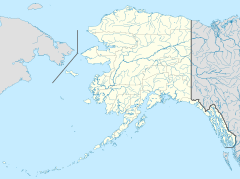Jack Wade, Alaska facts for kids
Jack Wade is a small, unincorporated community in the Southeast Fairbanks Census Area of Alaska, United States. It sits at an elevation of about 2,428 feet (740 meters). You can find it along Wade Creek, roughly 46 miles (74 km) south of Eagle, very close to the Canada–US border.
This community began as a mining camp around the year 1900. It was named after Jack Anderson and Wade Nelson, who were the first people to find valuable mining claims there. Jack Wade even had its own post office starting in 1901, which operated until 1948.
Quick facts for kids
Jack Wade
|
|
|---|---|
| Country | United States |
| State | Alaska |
| Census area | Southeast Fairbanks |
| Elevation | 2,428 ft (740 m) |
| Time zone | UTC-9 (Alaska (AKST)) |
| • Summer (DST) | UTC-8 (AKDT) |
| GNIS feature ID | 1404039 |
Contents
A Look at the Past: Population
Jack Wade was counted in the U.S. Census as an unincorporated village in 1930 and 1940.
- In 1930, 13 people lived there.
- In 1940, the population grew to 21 people.
After 1940, it was no longer listed separately in the census.
Gold Rush Days: The History of Jack Wade
The history of Jack Wade is closely tied to gold mining. Miners often had to file their claims in two different places, Dawson City in Canada and Eagle in Alaska. This was because they weren't always sure if their claims were in Canada or the United States.
Early Mining and Naming
The very first mining claims on Jack Wade Creek were made in 1892. People have been working these claims almost continuously ever since. The creek itself was named after Jack Anderson and Wade Nelson, who were the first to discover these valuable mining spots.
Mining Operations and Dredges
In 1936, a large machine called a bucket line dredge was bought by the Yukon Placer Mining Company. This dredge was used to dig up gravel and extract gold. It was taken apart and moved by horses over the ice to Jack Wade Creek.
In 1938, a man named Fred Whitehead was hired to build a small airstrip at Jack Wade Creek. He also built another airstrip for Franklin, on a ridge between Franklin and Jack Wade. These airstrips made it easier to bring supplies and people to the remote mining areas.
George Robinson: A Miner's Life
George Robinson started working for "the Company" at Jack Wade in 1932. He left to serve in a war in 1941, but returned to the creek in 1949. In 1951, George bought the Jack Wade mining operation from the company. He continued mining on his own until the early 1970s, when his health made him slow down.
George lived in a log cabin that was built around the early 1900s. He loved to share stories about the old miners and their adventures. He talked about good and bad mining seasons, and how he would walk to Dawson for a few days of cards and fun. He also told tales of finding very large gold nuggets, some weighing 25, 33, 56, and even 70 ounces! George's way of life didn't change much from when he first arrived at the creek 55 years earlier. He passed away in 1989 at 83 years old.
Challenges and Changes
In 1986, the Bureau of Land Management (a U.S. government agency that manages public lands) told George that his mining claims were no longer valid. Also, a group called the Sierra Club (an environmental organization) had a court order. This order aimed to stop 85% of mining in Alaska by the end of the 1987 season. This news was very difficult for George, as it threatened his income and his traditional way of life.
However, George Robinson fought for his rights in court. He successfully argued his case and got his mining claims back, allowing him to continue his mining lifestyle.


